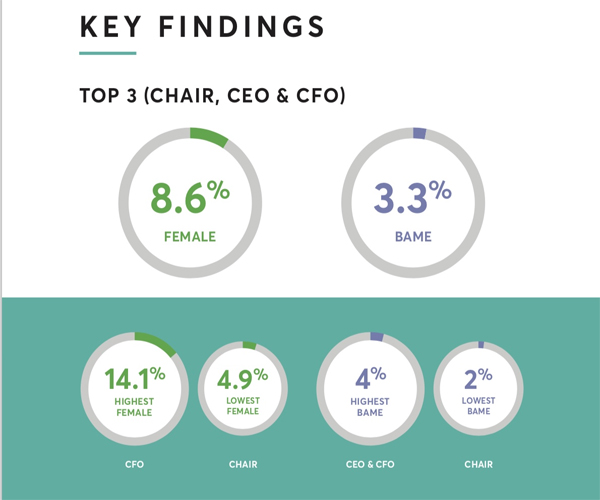
Britain’s leading companies are still failing to improve ethnic diversity at their leadership levels, with the total number of Black, Asian and minority ethnic (BAME) Board members actually dropping over the past year, according to the latest research from Green Park.
At 3.3%, the number of BAME Chairs, CEOs and CFOs (10 individuals) has not improved over the past six years, according to the London-based executive recruitment and diversity consultancy. At the Top 20 level, BAME Directors and Non-Executive Directors in the FTSE 100, has dropped over the past year to 7.4%, down from nearly 9% in 2018, with only a marginal increase from 6.2% in 2014.
SIGNIFICANT CONCERNS
Meanwhile, BAME representation at the Top 100 Level (the leadership pipeline of senior leaders who report into the Top 20) remains flat year-on-year, at 10.7% in 2019, compared to 10.6% in 2018. These statistic raise significant concerns about the prospects for any future improvement at Board and Executive committee level, says Green park.
Forty-Seven companies still have no ethnic minority membership at Board and Executive Director level – just 14 less than in 2014. At this rate of change it will take until 2039 before all FTSE 100 Boards and Executive Committees have ethnic minority representation; a far cry from the Government backed target set out by Sir John Parker to have no all-white boards by 2021.

EMPTY PIPELINE
“Our latest analysis shows that after five years of monitoring, the promise that things would change over time for ethnic minority leaders in the FTSE 100 looks just as empty as the corporate pipeline,” commented Trevor Phillips OBE, Chair of Green Park and founding Chair of the Equality and Human Rights Commission. “Women are cracking the glass ceiling; but people of colour remain super-glued to the corporate floor.”
“If the UK’s companies continue to ignore the experience and actions of their US competitors, they risk falling behind. With this attitude, post Brexit, we can expect talented female and minority executives – just like many of our minority actors – to exit to the USA to get a break.”
Forward-thinking corporations are realising that they need to do more than talk about change and are putting resources behind – and giving authority to – a Diversity and Inclusion leader, usually in the shape of a C-Suite executive.
A US PERSPECTIVE
In the US, almost half (47%) of S&P Index companies have a Chief Diversity Officer, with two thirds of these roles filled within the last three years, for example at businesses such as General Motors, Walt Disney, Time Warner, Mastercard, Bank of America, Coca Cola and Walmart.
However, there are very few British equivalents and those that exist, such as BP, are companies with the bulk of their operations led from the USA. Green Park believes that companies, particularly the FTSE 100, should follow this lead by creating and properly resourcing Chief Diversity Officer roles.
‘PATCHY PROGRESS’
On a positive note, The Green Park Leadership 10,000 report reveals that progress on gender diversity is continuing, with a record number of female leaders at Board and Executive Director level (28.8%). However, these increases are mainly in white rather than ethnic minority women, whose representation at this level has dropped over the past year from 3.1% to 2.8%, while white females have increased from 23.2% to 26%.

“The increasingly patchy progress in many sectors may be a sign that some companies find it hard to focus on diversity in the true sense of the word, opting for concerted effort in the areas of gender or race, but struggling to consistently address both,” stated Raj Tulsiani, CEO of Green Park. “If British business is serious about presenting a modern face to the world it needs to properly invest in Diversity and Inclusivity leadership, and give those leaders the resources to match.”
Click here for a copy of the report.




































